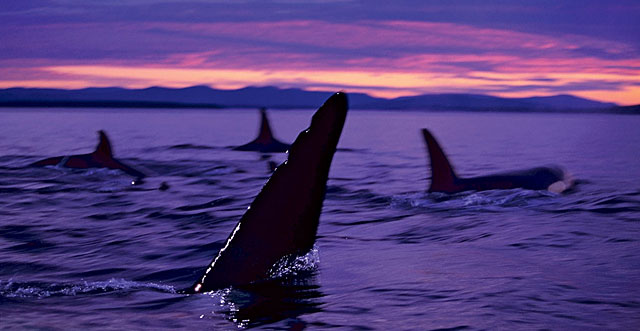sierraclub.org - sierra magazine - jan/feb 2012 - explore
 Haro Strait is home to a pod of more than 80 orcas, known as the Southern Residents, which were declared an endangered population in 2005. | Photo by Brandon Cole
Haro Strait is home to a pod of more than 80 orcas, known as the Southern Residents, which were declared an endangered population in 2005. | Photo by Brandon Cole
"It was not a wave, but
a smooth rolling swell
that seemed to come up
from the deeps, as if
something vast down
there had stirred itself."
—John Banville, The Sea
Moments after we emerge from placid Smallpox Bay, 18-knot winds plaster our hair to our faces and choppy currents rock our kayaks in the exposed waters of Haro Strait. We find refuge in a tangled bed of bull kelp, where salty ribbons anchor us.
It's July, peak season for seeing the orcas that lurk in this channel connecting the Strait of Georgia and the Strait of Juan de Fuca. As we glide away from our seaweed sanctuary, we're prepared to "raft up" again at the first sign of a fin. Paddles graze jellyfish as we behold the sheer, jagged west coast of Washington's San Juan Island. We pass petrograms inscribed centuries ago, a lazy harbor seal ("rock sausage," our guide calls it), and a red-footed pigeon guillemot with a fresh catch.
The guide's radio alerts us that a pod is headed our way from the south to feed on migrating salmon. But disappointment supplants excitement when conditions around the next bluff prove too dangerous for us to continue.
As we return to Smallpox Bay (a name taken from the plague that decimated the area's indigenous tribes and that belies the beauty of the place), an eagle with a wingspan as wide as our paddles soars overhead and lands in a tall Douglas fir. The bird sighting inspires, but we haven't given up on the killer whales. We return by foot to the cliffs we'd admired from below. Pink light slides down the snow-covered Olympic range, but our eyes fix on the water.
Stillness. And then suddenly a black speck pierces the surface, followed by a splash. I jump at the sight of four dorsal fins silhouetted against the glowing water. Tails boom on the surface.
Night is falling, and we haven't yet set up camp. But we refuse to leave, even when the orcas disappear around the headland. Our patience pays off. Like giant boomerangs tossed gently up the channel, they return in the glittering moonlight. Each time they take a heavy breath, I lose my own. —Molly Oleson